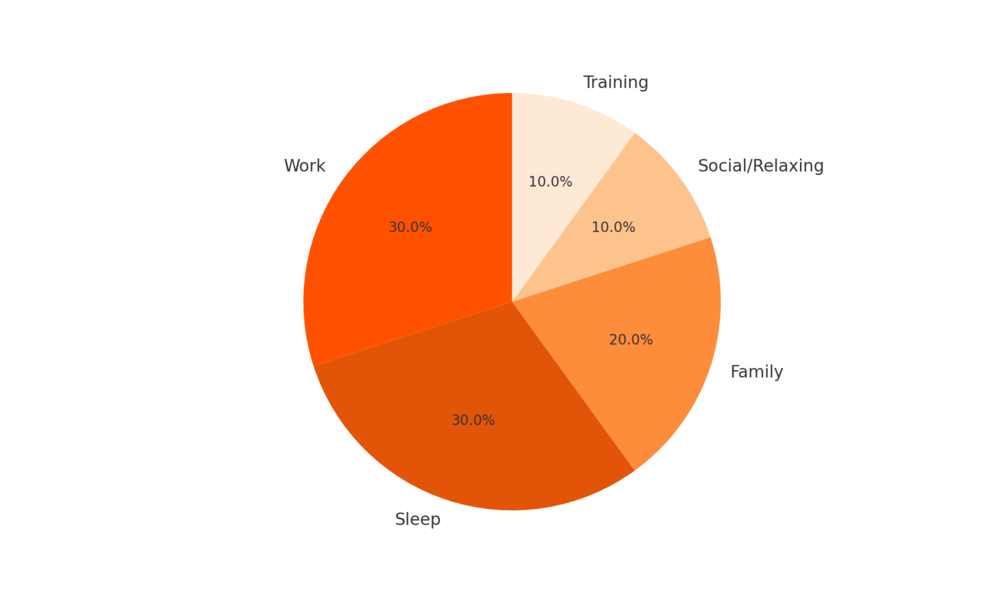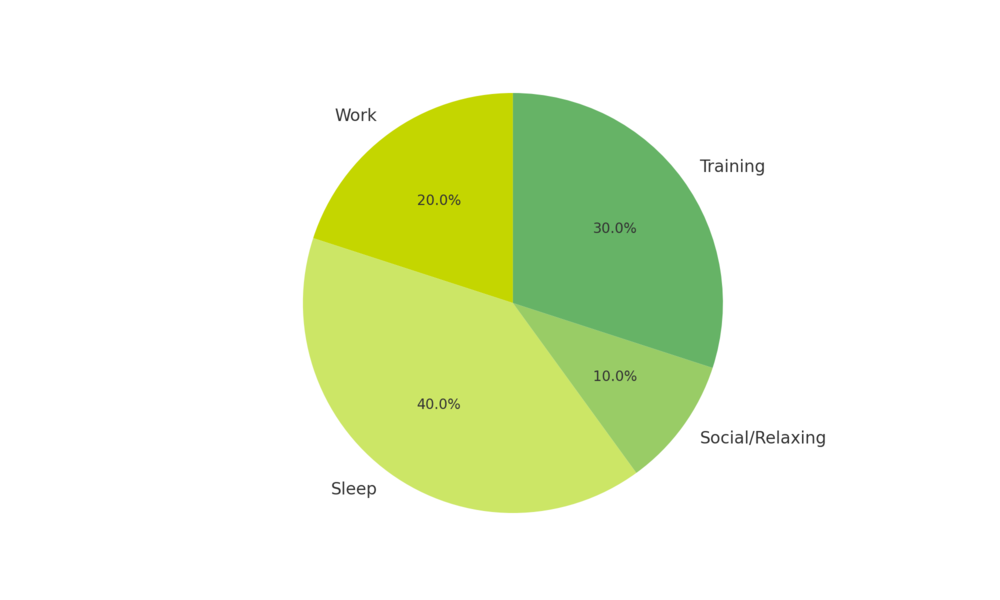While we have different interests, goals and personal situations, one thing that we all have in common is 24 hours in our day. We have an equal quota of time to distribute and invest our energies, but the challenge for most of us is finding a balance when trying to juggle family, work, training, a social life, sleep, rest and relaxation.
Our unique lifestyles and how we structure our days means that what constitutes ‘balance’ will vary for each of us. When trying to juggle multiple factors to ensure we’re performing at our best in each role, it’s worth considering 24-hours to be 100% of your day.
The age-group athlete with a ‘9 to 5’ job and a family might designate ~30% of the day to sleep, 30% to work commitments, perhaps 20% to family time, 10% to social time and relaxation, and the remaining 10% to training opportunities. This example might represent a fairly ‘typical’ working athlete with a young family during the key training block leading towards a goal event.

Let’s now consider a full-time professional athlete looking to make their career choice viable. Given the extra training demands, they might designate 40% of their day to sleep, 20% to work commitments such as marketing themselves and comms with sponsors, 10-20% to relaxation and 20-30% to training. A couple of glaring omissions in this example is social time (group training might partly account for this) and family commitments, where in this example our pro is an independent athlete in their 20’s who’s waiting for their pro career to evolve before starting a family.

The two examples above show how different balance can look based on life circumstance. It may come as no surprise that the training window (and leftover energy after all the other commitments are met) is drastically less for our age-grouper compared to our pro.
Sure we could slash our work and family commitments to free up time for more training, but the boss, colleagues, partner, children, clients or staff will no doubt feel the difference that the reduction in time and energy invested will make. Much like when family and work commitments are high and our training suffers, we’re constantly having to reassess and recalibrate how best to ‘balance’ our time quota each day, week and month.
In other words, how an optimal balance looks on Monday may be different to Saturday, and in a build week versus a recovery week, and during off-season vs race season. Once we understand what 100% of our time quota looks like in terms of 24 hours a day, we can begin to break down how we can still train effectively whilst maintaining healthy relationships and performances in our professional and personal lives…
Periodisation
If you’ve ever sat down to plan out a season, you might be familiar with the concept of ‘periodisation’. This is, the division of a season into various training ‘phases’ that each have a unique focus and desired training outcomes, all of which contribute to the overall goal.
I find this process very useful in building a picture alongside my athletes of how their personal and professional lives can be shaped in a way that fosters each training phase and vice-versa.
Ultimately, we invest our time and energy into the things that are most important to us. So when I sit with my athlete and he tells me how important being a father to his children, I know this needs to be reflected in his training. If he tells me his job is very demanding and he’s passionate about meeting job expectations, I know this will further contribute to the training landscape.
Many of my age-group athletes who have family and work situations like this will often cap their training volume at 8-10 hours per week total. This is unlikely to earn them qualification for the IRONMAN World Championships, so their goals need to reflect this. If you look closely at the age-group athletes that typically compete in the flagship qualification events such as Kona, they’re usually in a situation where either family or work commitments are reduced during their key training block. They might not have children, or they have a very supportive spouse, or their kids have grown up and left home. They might run their own business which allows them working flexibility, or they work part-time, or are retired.
Balance is a case of working to the same 24-hour daily time quota as everyone else, prioritising where you invest your time based on your values, then going about your day knowing that your performance, engagement and return on investment in each aspect of your life will inevitably reflect the time and energy you put in.
It’s no accident athletes who invest more time and energy into their training see better self-improvement and performance outcomes. The father who invests more time into his children develops a closer, more rewarding and loving relationship with his kids. The age-group athlete whose commitment to her medical studies means she drops swimming and cycling from her program, goes on to become a highly regarded doctor while keeping a running routine. We’re the product of where we place our time and energy, driven in large part by our passion and our values.
Make a plan
Keep in mind the balance equation is a constantly moving target and you can use this to your advantage. When I planned my own season as a ‘working professional’ when my children were young, I would sit with my wife and we’d map out the year, so we knew when I’d need more support from her with the kids to free me up for key training and recovery blocks.

Through this process we’d also be able to identify times in the year (off-season, recovery weeks, lighter training phases) where I’d be more available in my parenting role and she’d have more opportunity to more vigorously chase her own passions and work commitments. In other words, with a little bit of forward planning there’s great scope for give and take. Likewise within your work environment or social circles, you can be clear on when training will demand more of your time and attention, and when you’ll be throwing in overtime or parties with your mates.
A frustration to me as a coach can be when an athlete who prefers to invest heavily in their training for 12 months of the year complains about their poor performances at work or their strained relationships at home. Or an athlete who identifies a need to meet high work demands and spend quality time with their family, complains that they didn’t podium in their race. It’s our distribution of time and energy that’s always reflected in how we perform in each aspect of our life. You get what you give.
Next time you reflect on your life balance, try to consider it as a case of investment. I tend not to use the word ‘sacrifice’ as it tends to depict ‘giving up’ something. I like the word investment because it captures how we have the ability to choose where to divide our time and energy based partly on necessity but also what we value and feel passionate about.
It’s also important to keep in mind how changeable our set of circumstances is. Different aspects of life will demand different levels of investment as the days, weeks, months and years evolve. So try to stay kind to yourself when you sense you ‘have lost your life balance’ as it’s something that always requires adapting and recalibration as life moves along and evolves.
Family circumstances always change as relationships progress or kids grow up. Work situations demand fluctuating levels of focus and how you choose to spend your downtime evolves too. So once again, having a plan can be a useful way of staying on track with how you balance all the moving parts.
Just as training commitments shift as you move from a base phase to a build phase, or from race season into an off-season, other aspects of life are always changing too. If you have planned for this you can ‘give and take’ your application of invested time and energy as the months and years go by. Then with all the inevitable ‘unforeseen’ things that pop up you can always lean into your values to help steer the ship.
After all, what we value and the things that matter most in our life always offer a compass to help steer us through the distribution of time and energy during each 24-hour day.
